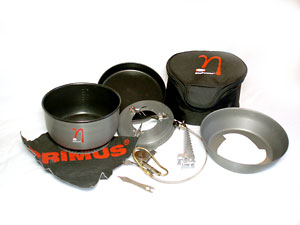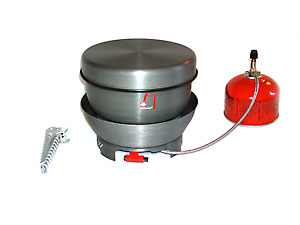(Editor’s note: in our January comparison of integrated canister stove systems, we mentioned the then-untested Primus EtaPower EF as a possible wild card. Since then we’ve had the opportunity to put the EtaPower through the same battery of tests we conducted with the other stoves. This review takes an up-close look.)

The $110 Etapower EF includes a stove base, burner, windscreen, pot, pan, carrying case/cozy, pack towel, pot gripper, and maintenance tool.

The assembled EtaPower EF base, burner, windscreen, pot and pan/lid.
For those of us accustomed to buying camp stoves and cookware separately, the act of unboxing the Primus EtaPower EF can be a bit overwhelming. The sheer number of parts included is initially overwhelming. Nested inside a zip-closure insulating cozy, the EtaPower kit includes a stove base, burner, windscreen, 2.1-liter pot, frying pan, pot grabber, pack towel, maintenance tool, instruction booklet, and promotional DVD. For $110 that’s a fair amount of hardware.
But once assembled, the EtaPower appears neither overwhelming nor all that radical. All the components are recognizable: a burner with remote fuel canister attachment, a 2-liter pot and frying pan, and a circular aluminum windscreen. But put those parts together and they add up to one of the fastest and most fuel-efficient cooking systems on the market.
Building on the concept first introduced by Jetboil, the EtaPower pot features a built-in ring of heat-exchanger fins welded to its base. Those fins capture heat from the burner and channel it into the pot, heating your dinner instead of the surrounding air.
The EtaPower is closest in design and intended usage to the Jetboil GCS. While the GCS was designed as a group-sized addition to the popular Jetboil PCS, the EtaPower was envisioned from the ground up as a communal cook pot. The 2.1-liter pot and included frying pan are large enough to handle cooking duties for a small group, and both feature non-stick coatings.
Because of its size and weight, the EtaPower is not appropriate for solo travel. However, Primus is planning to introduce a solo-sized stove, the EtaExpress, in 2008, along with a multi-fuel version of the EtaPower.
Boil Time
The heat exchanger on the EtaPower pot is designed to effectively transfer heat from the burner to the pot, while the windscreen keeps the heat where it belongs. Coupled with a hotter burner than those found on the Jetboil stoves, the EtaPower achieves impressive boil times.
Under controlled conditions and using a full canister of isobutene/propane mix, the EtaPower EF boiled its first liter of water in just 3:30. The EtaPower’s average boil time of 3:39 per liter in calm conditions is second only to the MSR Reactor among the integrated canister stoves we've tested.
As with all canister stoves, performance decreases with time, as lower fuel pressure in the canister delivers vaporized fuel more slowly to the burner. But unlike the other integrated canister stoves we’ve tested, the EtaPower EF features a remote canister mount, which allows you to operate the stove with the canister inverted. This setup delivers liquid fuel to the burner and restores full-canister boil times even when you’re running low on gas or operating in cold weather. The downside is that fuel efficiency will suffer somewhat. Also, the stove takes a long time (30-40 seconds) to stop burning when used with the canister inverted. Even after you close the valve there’s liquid fuel in the line that must be vaporized and burned.
Fuel Efficiency
At an average of just 9.5 grams of fuel per liter boiled in calm conditions, the EtaPower is a serious fuel-miser. In ideal conditions, the EtaPower will boil 23 liters of water on a single canister. And as noted above, this efficiency comes without sacrificing boil time.
Primus claims that you’ll save weight in fuel carried. This is technically true, but only comes into play on those trips where you’d otherwise be carrying multiple canisters between resupplies. For a typical weekend trip there’s likely no weight savings (unless you’re doing some very serious cooking). But on expeditions, extended winter camping trips, or other trips that require boiling a lot of water, those saved grams will start to add up.
Real-World Performance
The EtaPower’s integral windscreen allows it to perform reasonably well in windy conditions. While the base/windscreen configuration doesn’t entirely eliminate the energy-sapping effects of the wind, it provides adequate protection in most conditions.
In our tests in an 8 mph wind, the EtaPower was able to boil a liter in 6:04, using just 14 grams of fuel, comparing very favorably to the Jetboil GCS’s 18-minute boil in the same test.
Compatibility
The EtaPower system was designed to be modular. The heat-exchanger pot is available separately and can be used with most other stoves, and other pots can be used with the EtaPower stove. However, the manufacturer warns against using the windscreen with non-EtaPower pots, which sit lower on the pot supports, closer to the burner head, and could cause incomplete combustion. Neither setup is likely to be as efficient as the combination of an EtaPower stove and pot.
Cooking
Despite its impressive boiling performance, the EtaPower is also clearly suited to preparing more complicated meals. It is the only integrated canister stove to come with a frying pan (Jetboil offers a fry pan separately), and the 2.1-liter pot is easy to handle and cook with. Both the pot and pan feature Primus’s “Titanium nonstick” coating and are constructed of a fairly heavy gauge anodized aluminum, which helps eliminate hotspots and provides a more even cooking surface. There is enough fine adjustability at the low end of the output range to manage a decent simmer.
Primus advises against using the frying pan with the windscreen, requiring you to either forego the benefits of the windscreen altogether or to turn off the stove, wait for it to cool, and remove the windscreen between using the pot and the frying pan.
Ease of Use
The EtaPower initially appears somewhat complicated to put together, although after you’ve done it once the setup becomes obvious. Unfortunately for the less mechanically gifted the included instructions are not nearly as clear as they could be. They skip around through safety and usage before getting to actual assembly instructions, completely ignoring the crucial step of connecting the burner to the stove base, but dedicating four steps to attaching the gas cartridge. There are also a number of typos and references to components that are not labeled in the diagrams. (The EtaPower also comes with a DVD labeled “Instructional Films.” Unfortunately it contains no instruction — just several short videos promoting Primus’s various stove lines.)
The windscreen is held to the stove base by three friction-fit clips and can easily be knocked loose. But this also makes for quick changes when switching between the EtaPower pot and the frying pan or third-party cookware, which Primus recommends not be used with the windscreen in place.
Not surprisingly for a stove with sub-four minute boil times, the EtaPower’s burner shoots up a very tall flame when there’s no pot on the stove. As with any stove, it’s a good idea to only light the burner after placing a pot on the stove, and to turn it off before removing the pot. Part of being fuel-efficient means lighting the stove only when you have a pot cooking/boiling. You’ll find yourself using less fuel if you only leave the stove on where you’re actively cooking or boiling.
A simple ring around the bottom of the heat exchanger makes it easy and secure to put the pot on the stove (or on any other stove). This design avoids a problem we’ve had with the similarly-design Jetboil GCS, where the heat exchanger fins can easily catch on the stove’s pot supports, creating some awkward moments when moving the pot on or off the burner.
The EtaPower’s features go beyond the GCS in several areas: the windscreen provides protection and heat retention that the Jetboil lacks. The remote canister and low-slung base make the EtaPower very stable and easy to adjust.
Conclusion
Primus appears to have found the sweet spot between boil time and fuel efficiency. The EtaPower EF is nearly as efficient as the Jetboil GCS, while boiling in about half the time. The EtaPower’s windscreen, while not perfect, allows it to work commendably in conditions that stymied the GCS.
For extended trips that involve cooking for a group, the EtaPower EF’s combination of size and efficiency make it a very attractive option.

 by Dave MacLeay
by Dave MacLeay









